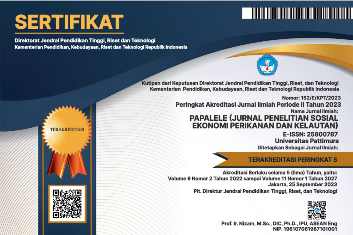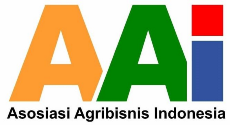EFISIENSI TEKNIS DAN EKONOMI PERIKANAN TUNA HAND LINE DI NEGERI TIAL KABUPATEN MALUKU TENGAH
Abstract
The resources of large pelagic including tuna (Thunnus sp) in Maluku are quite potential with moderate status and must be utilized optimally. In Tial, the utilizing of these resources uses hand lines; especially fishing line. Tuna hand line is classified as small-scale fisheries which has various problems. One of it is fishing inputs allocation that leads to inefficient. This study in general aims to analyze the hand line tuna fisheries business based on technical and economical efficiency. It was conducted by using survey method in Tial, Central Maluku Regency for 20 units hand line fishermen. Data was analized by Cobb-Douglas production function approach to identify efficient inputs; several financial parameters to determine business feasibility; and CPUE to measure the level of technical productivity. The results show that efficient production factors are fishermen’s fishing experience and fishing frequency. During the four months of observation, all business units made an average profit of Rp 31,199,139 or Rp 458,810.86/trip. R/C and PP parameters show that the business is feasible to be developed; while the largest ROI (135.2%) is in the 18th business unit. Business units that have CPUE >1 are unit 1st, 2nd, 3rd, 5th, 6th, 9th, 11th, 12th, 13th, 14th, 15th, 16th, 17th, 18th, 19th and 20th. Based on several technical-economical measurements, the hand line tuna fishery business in Tial is efficient and feasible to be developed.
Downloads
References
Baridwan, Z. 2010. Intermediate Accounting. Edisi Ketujuh. Badan Penerbit Fakultas Ekonomi Universitas Gajah Mada. Yogyakarta.
Fauzi A. 2010. Ekonomi Perikanan. Teori, Kebijakan, dan Pengelolaan. PT Gramedia Pustaka Utama, Jakarta. 124 hal.
Firdaus M. 2012. Manjemen Agribisnis. Penerbit Bumi Aksara, Jakarta. 221 hal.
Guland J.A. 1954. The Economics of a Common Property Resources; The Fishery.Journal Political Economy. Canada.
Irawati S. 2007. Akuntansi Dasar 1 dan 2. Penerbit Pustaka. Bandung. 430 hal.
Merta, I.G.S., B Sadhotomo, S.B. Atmaja dan Wudianto. 2004. Musim Penangkapan Ikan Pelagis dalam Musim Penangkapan Ikan di Indonesia. Balai Pendidikan Perikanan Laut. Pusat Riset Perikanan Tangkap. Badan Riset Kelautan dan Perikanan. Departemen Kelautan dan Perikanan.
Nakamura H. 1991. Ditemukan Tujuh Jenis Ikan Tuna. Bali Post 12 April 1991. Hal 10.
Rahmat E dan Thamrin I. 2016. Teknologi Penangkapan Ikan Tuna dengan Alat Pancing Ulur di Laut Banda oleh Nelayan Maluku. Buletin Teknik Litkayasa. Vol. 4 No. 1 Juni 2016
Sarwono. 2006. Metode Penelitian Kuantitatif dan Kualitatif. Penerbit Graha Ilmu Yogyakarta. 236 hal.
Siahainenia St.M. 2016. Determinasi Produksi dan Pendapatan Nelayan Purse Seine di Kecamatan Leihitu Kabupaten Maluku Tengah. Prosiding. Semnas Kelautan dan Perikanan ke-III. Kupang 27 Oktober 2016. Hal 195-201.
Sudirmnan H, Nelwan A, Kurnia M, Zainuddin M dan Nessa N. 2017. Perikanan Pelagis Besar (Tuna, Cakalang dan Tongkol). Penerbit Yarsif Watampone, Jakarta. 200 hal.
Soekartawi. 1997. Teori Ekonomi Produksi dengan Pokok Pembahasan Analisis Fungsi Produksi Cobb-Douglas. Manajemen PT RajaGrafindo Persada Jakarta. 257 hal.
Copyright (c) 2019 Priscyllia Franetha Siahainenia, Dionisius Bawole, Willem Talakua

This work is licensed under a Creative Commons Attribution-NonCommercial 4.0 International License.











